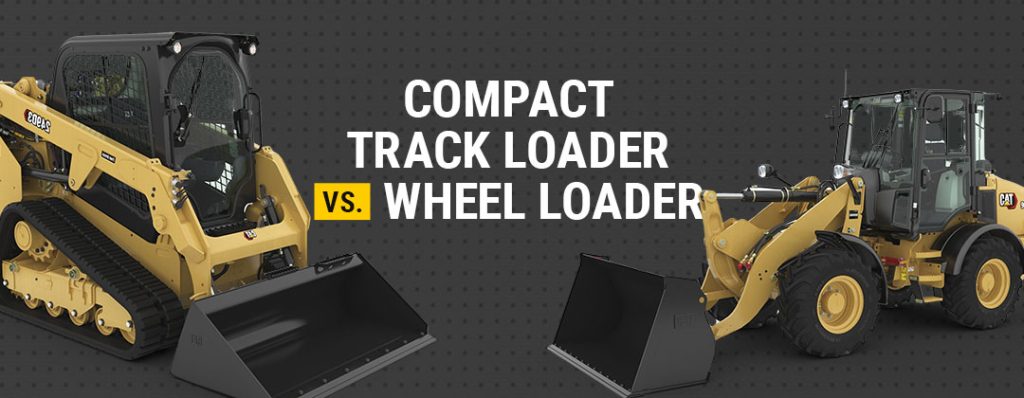
If your business wants to add a compact track loader (CTL) or wheel loader to your current equipment lineup, many factors will determine which model is right for you.
Learn the similarities and differences between the two and how Gregory Poole Equipment Company’s expertise in Cat® equipment will help you make the most informed decision.
CTLs and wheel loaders can be a useful addition to your existing fleet. However, when choosing between the two, you’ll need to consider their different features and distinctions. These types of equipment serve slightly different functions, and you can benefit from learning more about each. Here’s a quick wheel loader vs. track loader comparison:
A compact track loader is a relatively small piece of equipment that runs on two parallel tracks rather than wheels. They are a popular choice for the construction, landscaping and agricultural industries.
Here are some of their key features:
A wheel loader is similar to a CTL in that they both typically feature a bucket in front and are popular in the construction industry. However, wheel loaders run on four wheels instead of tracks and are better suited for slightly different applications.
Here are the main features of wheel loaders:
While there are many similarities between wheel loaders and compact track loaders, you should know some differences before choosing one piece of equipment over the other. The most obvious distinction is that CTLs move on tracks, and wheel loaders move on tires. Explore the other important differences below:
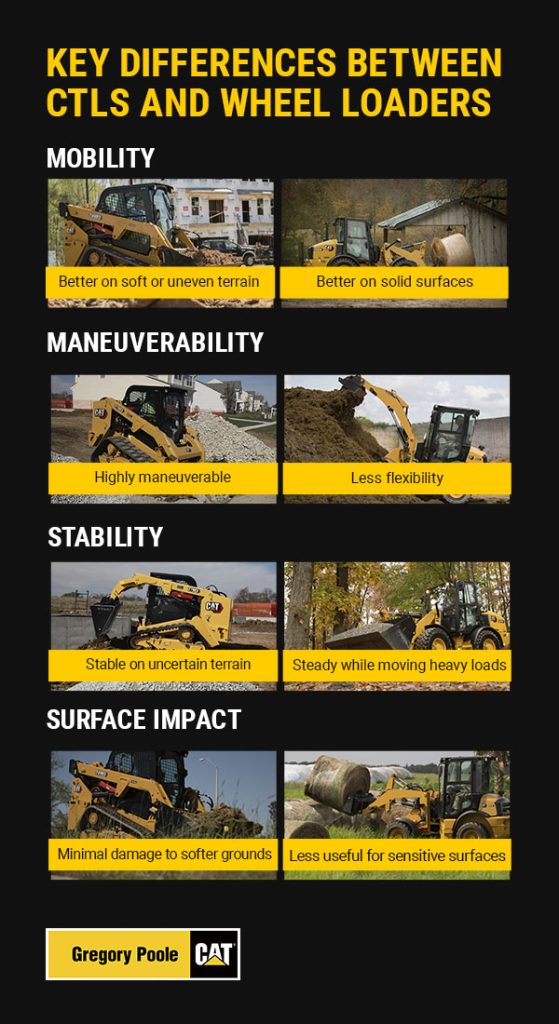
When determining whether a CTL or a wheel loader is the right addition to your fleet, you must consider the terrain and ground conditions you typically work with. The type of equipment you choose will impact job site productivity and performance. Explore the primary applications for CTLs versus wheel loaders:
Compact track loaders are well-suited for soft and sensitive terrain, like loose soil, snow, sand or mud. Their tracks offer additional traction, making them a good pick for the following applications:
CTLs are also better for jobs with slopes and inclines than wheel loaders. Their tracked undercarriage and low center of gravity make them effective in hillside landscaping or grading projects and forestry operations on hilly terrain.
These pieces of equipment are gentle on the ground surface, minimizing disturbance and outperforming wheel loaders. CTLs are the right choice for jobs involving the preservation of landscaping or environmental restoration. Because of their outstanding maneuverability, CTLs are also well-suited for tasks involving narrow and confined spaces, such as:
Wheel loaders outperform compact track loaders for certain applications and job site conditions. For instance, a wheel loader is best for working on hard, stable surfaces, including:
These pieces of equipment can also travel at higher speeds, enabling greater efficiency. Quick transport makes wheel loaders the go-to pick for load and carry applications, like transporting bulk materials across a construction site or large open space, such as a quarry or mine.
Wheel loaders also typically feature heavier lifting capacities and longer reach than CTLs. They are useful for stockpiling materials at storage yards or on construction sites. They are also suitable for handling large containers and pallets or hoisting heavy materials, such as rocks, logs and gravel.
In addition to all these diverse uses, wheel loaders can also streamline scraping and grading projects for road or pavement maintenance, clearing debris, and landfill operations.
When you invest in a compact track loader or a wheel loader, keeping up with the maintenance requirements is key to elongating the machine’s operating life. For both types of equipment, be sure to do the following:
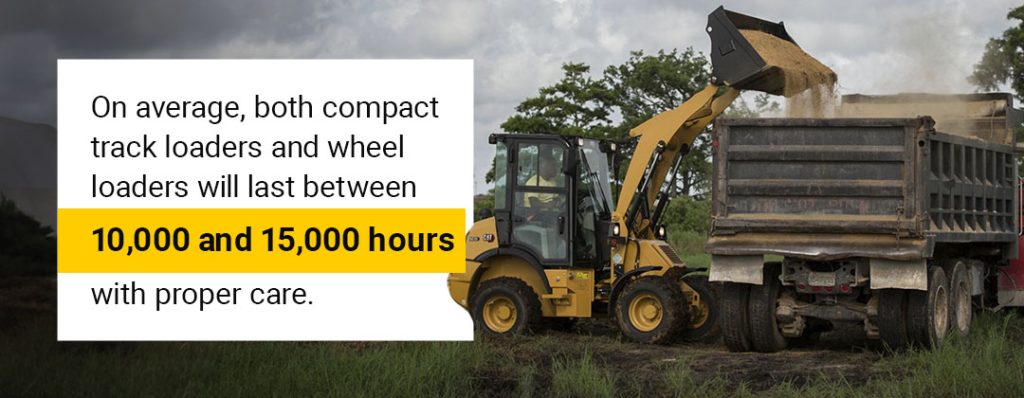
On average, both compact track loaders and wheel loaders will last between 10,000 and 15,000 hours with proper care. Now, let’s get into the main distinctions between maintaining each:
The maintenance requirements for a CTL differ from a wheel loader, particularly in terms of the tracked undercarriage. Taking care of your track is essential for long-term use and optimal performance.
Operators need to clean the track regularly, removing debris, mud and rocks after each use. Monitor the tension and make adjustments as needed to avoid premature wear and potential damage. Keep the track well-lubricated and replace it when it begins showing signs of significant wear.
A well-maintained track will last between 1,200 and 1,600 hours, on average. However, the exact hours will depend on the types of projects you work on regularly and how you operate the machine.
Wheel loaders typically have fewer maintenance requirements and lower upkeep costs than most compact track loaders, mainly because of the tracked undercarriage. Wheel loader maintenance tends to be simpler, and operators generally need to do the following:
Proper tire care is essential for optimal performance and safe operation.
When purchasing a CTL or wheel loader, the following factors will directly impact the equipment’s upfront costs:
In addition to these costs, you must be aware of the factors impacting operational and ownership costs, including:
When investing in heavy equipment, be sure to consider resale value. The following tips will help you preserve the worth of your machine to maintain the highest resale value possible:
The price you can sell your CTL or wheel loader at will depend on the following factors:
When determining whether to invest in a compact track loader or a wheel loader, be sure to explore the following considerations:
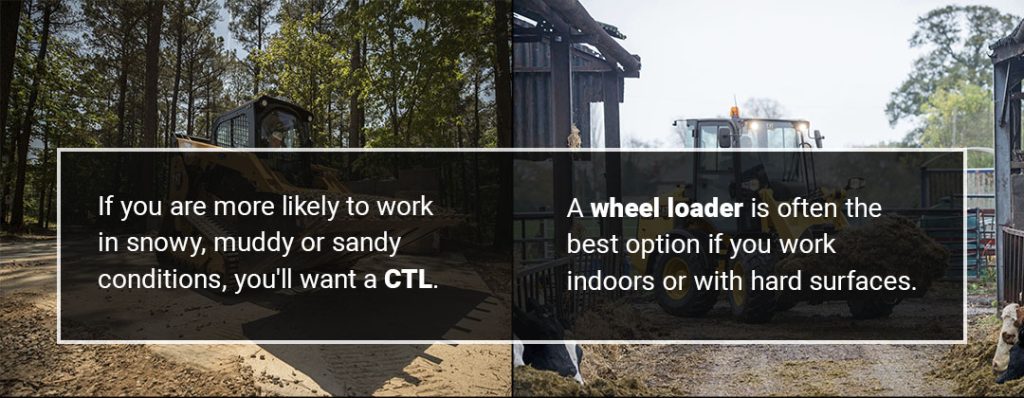
One of the most significant factors to consider when choosing heavy equipment is your typical applications. What types of job sites do you work with often? If you are more likely to work in snowy, muddy or sandy conditions, you’ll want a CTL. A wheel loader is often the best option if you work indoors or with hard surfaces.
You’ll also need to consider the attachments you’ll need for your CTL or wheel loader. Both types of equipment work with a wide range of accessories and work tools, such as:
Ensure you choose a loader that works with the types of attachments necessary for your business’s job requirements.
If you are looking for a compact track loader or wheel loader, you’ll need to determine whether you’d like to rent the equipment or buy it. Renting is typically best for short-term project needs or for businesses that do not have the budget to cover the upfront costs of purchasing. Buying is typically best if you need the equipment for long-term requirements. If you are purchasing equipment, another important consideration is whether to buy new or used.
Whenever you are investing in heavy equipment, it is crucial to work with a trusted seller. Research the business and explore customer testimonials to ensure they have a positive track record. Prioritize responsive customer service and ask if they offer repairs or maintenance services. Closely inspect the equipment and ensure it matches the listing from the seller. If there are any discrepancies, find another seller.
At Gregory Poole Equipment, we have over seven decades of providing our customers with quality products and services. We will help you determine which equipment is right for your unique requirements and deliver expert advice.
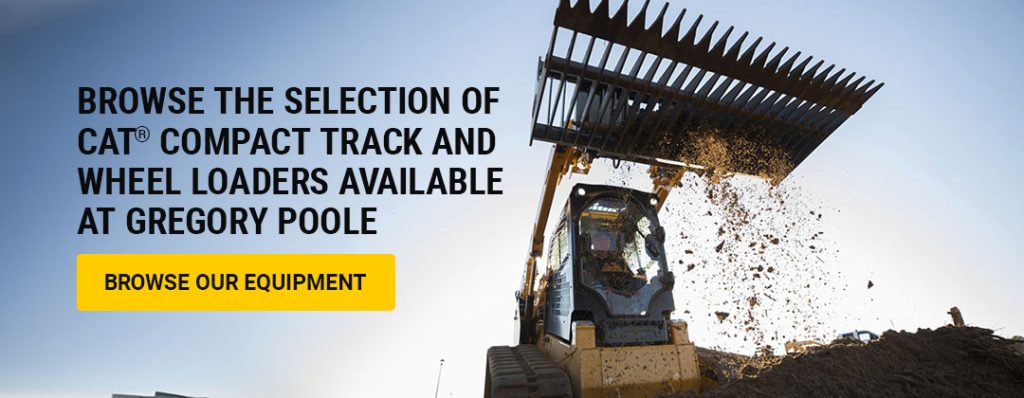
If you want to add a wheel or compact track loader to your fleet, turn to the options at Gregory Poole Equipment Company. We have locations throughout eastern North Carolina and over 70 years of experience delivering reliable, effective solutions for various industries.
We have a wide selection of new and used Cat equipment available, and our dedicated sales and product support teams will help you find the right model for your unique project requirements.
Browse our equipment online, or find the nearest Gregory Poole location today.